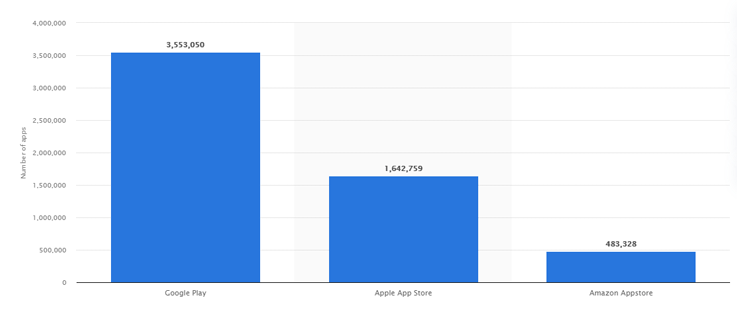The creative process of developing a mobile app is exciting, and one of the most exciting stages is the ideation stage. To generate fresh and exciting concepts, you can experiment with anything and anything that comes to mind. It’s important to remember that there are countless possible sources and methods for generating ideas. There isn’t a perfect solution that applies to every situation. This is the only opportunity to let your imagination run wild without fear of reprimand.
A wide variety of sources and methods serve as inspiration for mobile app development. Not everyone can fit into a standard size. There are several methods available for developing and testing app concepts. You can do as many repetitions as you like. An ideation framework is essential if you don’t want to sink without a trace during the app development design process.
If you’ve researched, gathered useful customer feedback, and planned out the buying process. At this point, you should go to the next stage, which entails a substantial immersion in your own ideas. But then what? One can utilize many strategies for idea testing and generation to create apps that stand out from the crowd. If you’re having trouble thinking of unique app ideas to make money, here are some activities you can incorporate into your brainstorming framework.
Explore the Current Trends and Identify What Could Have Potential
Research is essential when coming up with concepts for apps. Researching current trends might help you discover new app ideas and learn more about the mobile app market. You should sign up as a developer and then hire a coder once you have an idea for an app. Making an iOS app should be your first step if you want to monetize your app. Compared to the 2.87 million apps accessible in the Google Play Store, the Apple App Store boasts over 1.96 million.

Image Source:- Statista
Fewer apps are available for these systems. Many individuals are working on new app concepts, and there’s no reason you can’t join them. Don’t forget that there’s more to mobile apps than making a buck. What matters most is that difficulty is overcome. Let’s check out some of the most recent developments in the app industry to see what you can learn for your own app development.
1. Analyze Existing Apps in the Market
One of the best and simplest ways to think of an app idea is to look at the existing app for inspiration or clone it. Popular apps might serve as models for you to build upon. Many businesses use the Social Media Optimizing (SMO) strategy to boost brand awareness of their business. Facebook and Twitter are good examples of how people may learn from each other. The popularity of the social networking site Facebook is likely an inspiration for many similar apps. Look around you, including in crowded areas; don’t be afraid to.
Even if you do come up with a novel idea that ends up being successful, you should expect rivals to enter the market at some point. Having a horrible idea is the only way to stay ahead of the competition. That’s obviously not what you’re looking for. Alternatively, you might browse app shops in search of complementary apps to create something truly unique.
2. Identify Valid Problems & Solutions
Many available apps are made to assist users in overcoming common issues. These issues may originate in any sphere, from the realm of communications to that of the way of life. Determine where this kind of difficulty exists, and see if you can develop an app to address it. You can have also tried to locate an app on the internet and been unsuccessful. In other words, fabricate one. You can find any missing details by doing some digging online, particularly in the Google Play Store and the Apple App Store. You can also analyze the market for apps and create superior alternatives to ones that aren’t doing well.
3. Tap into User Stories
By observing (with an eye toward) and listening to your clientele, you can gain a wealth of useful information. Keep an eye on how buyers are using your goods and engaging with your brand. Mind where they hang out because that says a lot about them. Trace their steps as they interact with your goods and peruse your site. If clients are willing to give you their time, you must be offering them something of value. Start communicating with your audience when you’ve figured out where they hang out and how they browse your content. Try to engage them in discussion as much as possible to learn their true opinions about your company and products.
4. Develop Ideas Through Brainstorming Sessions
Whenever you’re trying to come up with innovative ideas for a mobile app, brainstorming is a great way to go. These sessions are for coming up with any kind of idea for the app, not just the best one possible. With the goal being to focus solely on the brainstorming process, it stands to reason that many interesting and potentially useful ideas will be generated during this time. Engage your brain and make a pact with yourself to generate fresh concepts daily. In the beginning, this may seem like a huge obstacle, but as you progress, you will begin to see it as less of a hurdle. You will get to a place where you look forward to it and even want to include others in yours.
5. Narrow Down the List of App Ideas
Reducing a long list of potential app concepts to a more manageable size in order to move forward with their design and development. When you’re faced with a huge list of possibilities, the next step is to cut it down to a manageable number. This may appear simple, but it’s not always easy to determine which of many potential options really merits further investigation. Your vast list of potential mobile app concepts needs to be whittled down. The process of strategically reducing app ideas to a prioritized shortlist is crucial to creating long-term business outcomes because app validation can entail a large expenditure.
6. A/B Testing With Different Concepts
You are able to make thoughtful adjustments to the user experiences of your customers by using A/B testing with different concepts while simultaneously collecting data on the effects of those adjustments. This enables you to formulate hypotheses and get insight into the reasons behind why particular aspects of their experiences have an impact on user behavior. Another way that they can be shown to be incorrect is through the use of an A/B test, which will demonstrate that their perspective of the experience that provides the best results for a particular aim is incorrect. A/B testing can be used to consistently enhance a given experience or improve a specific goal such as conversion rate over time.
Over to You
Brainstorming can be simple or complex, visual or virtual, but whatever method you choose to use, the results should be the same great ideas. Finding new ways to facilitate innovation is something we’re passionate about here at Nascenture, as we are a reputed mobile app development company that can find the above brainstorming techniques useful.





